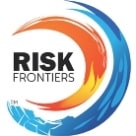New Zealand is subjected to significant levels of seismic hazard and seismic risk because of its location on the plate boundary between the Australian and Pacific Plates.
It is currently experencing a phase of elevated seismic activity, which began with the occurrence in 2010 of the magnitude 7.0 Darfield earthquake, soon followed in 2011 by the much smaller magnitude 6.2 earthquake which was nevertheless much more damaging because it occurred directly beneath Christchurch; the total economic loss of this earthquake sequence is estimated to have been $NZ 40B. Since then, a much larger earthquake, the magnitude 7.8 Kaikoura earthquake, occurred in the region between Christchurch and Wellington in 2016.
QuakeNZ Model Overview
QuakeNZ is a national earthquake model for New Zealand. It implements an earthquake forecast model for crustal, slab and subduction interface earthquakes, and uses a ground motion prediction model for all three of these earthquake source categories. Ground motion amplification uses a New Zealand-wide soil site classification. Damage is calculated using the full building response spectrum for residential, commercial and industrial property. In addition to calculating losses from earthquake shaking, it also calculates losses from soil liquefaction.
QuakeNZ incorporates data from GNS Science’s National Seismic Hazard Model (NSHM12), It implements the earthquake forecast model for crustal, slab and subduction interface earthquakes in NSHM12, which includes a spatially distributed seismicity model and a set of potentially active faults.
Using a 50,000 year event set within a Monte Carlo simulation framework, RF’s QuakeNZ2 calculates Probable Maximum Losses (PML) as a function of Average Return Interval (ARI) or Annual Exceedance Probability (AEP) throughout New Zealand.
QuakeNZ Features
Liquefaction damage
A liquefaction potential hazard map using inputs from high resolution GIS data is used to classify exposure based on a HAZUS methodology calibrated to the Christchurch experience.
Capacity Spectrum
To estimate losses, QuakeNZ uses the capacity spectrum method, with fragility curves that are derived from building-specific capacity curves for a wide range of NZ building construction types and vintages, and from event-and-site-specific broadband response spectra.
NZ Specific Financial Module
The financial module can take into account NZ specific requirements such as the Earthquake Commission deductibles and the calculation of regulatory probable maximum losses.
Who can utilise QuakeNZ?
Insurers/ReInsurers
QuakeNZ was developed by Australian seismologists and engineers who frequently visit New Zealand, especially after damaging earthquakes, and are familiar with local conditions in New Zealand.
Emergency Response
Risk Frontiers personnel have firsthand experience with major earthquake events, offering valuable insights into lifeline interdependencies critical for effective emergency response planning.
Utilities
Risk Frontiers is familiar with the utility systems that operate in New Zealand and can obtain scenario-based estimates of losses from events that impact distributed utility systems.
QuakeNZ Technical Specifications
Hazard Resolution – Ground Shaking | Variable resolution, down to 500m |
Hazard Resolution – Liquefaction | High resolution source GIS data down to 16m |
Exposure Resolution | Location Address Level |
Event Catalogue | 50,000 years of stochastic earthquakes |
Ground Shaking, Liquefaction and Exposure Parameters | Location, full acceleration demand spectrum, soil type, building construction type, building age, building height. |
Line of Business | Residential / Commercial / Industrial |
Business Interruption | Commercial / Industrial |
Coverage | All Properties on mainland New Zealand |

Behnam Beheshtian, Risk Engineer
Learn More About QuakeNZ
Get the opportunity to speak with the team who developed the QuakeNZ model.
Briefing Notes
Read our latest research
Delve into the insightful articles on climate risk and resilience from the team of risk scientists at Risk Frontiers.
Roman concrete 2: Discovery of the chemical processes could lead to the commercialisation of Roman-inspired hot-mixed concrete mixtures
Roman Concrete 2: Discovery of the chemical processes could lead to the commercialisation of Roman-inspired hot-mixed concrete mixtures Jacob Evans In 2018 Risk Frontiers published
Hurricane Helene: The significance and destruction
Hurricane Helene: The significance and destruction Jacob Evans, Risk Frontiers Hurricane Helene was the strongest hurricane (tropical cyclone) on record to strike the Big Bend
How much longer will the Muswellbrook earthquake swarm last
How much longer will the Muswellbrook earthquake swarm last Paul Somerville The ongoing Muswellbrook earthquake swarm (Risk Frontiers, 2024, Briefing Note 503) has now continued
